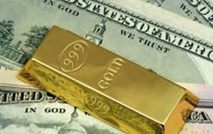April ECB Meeting And Gold

 Last week, the European Central Bank released its most recent monetary policy statement. What does it imply for the US dollar and the gold market?
Last week, the European Central Bank released its most recent monetary policy statement. What does it imply for the US dollar and the gold market?
No Fireworks After March’s Bazooka
The recent ECB meeting was unexciting. Draghi left interest rates unchanged and neither expanded existing programs nor introduced any new policy measures. The quiet meeting should not surprise us – the ECB announced a wide-ranging stimulus in March, therefore, nobody expected any fireworks in April. Instead, as decided in March, the ECB expanded its monthly purchases under the asset purchase program to €80 billion from the previous amount of €60 billion and released further details of its corporate sector buying program.
Better Outlook, But Risks Remain
Generally speaking, Draghi was slightly more optimistic than in March. Euro area real GDP increased by 0.3 percent quarter-on-quarter in the fourth quarter of 2015, and it is expected to rise at a similar pace in the first quarter of 2016. Moreover, inflation rose to 0 percent in March from -0.2 percent in February. Loan dynamics also improved. Therefore, the economic recovery is expected to continue, of course, thanks to the ECB’s monetary policy measures. However, risks remain tilted to the downside, given the uncertain growth prospects in emerging markets. Additionally, Draghi’s heroic actions could be counteracted by the balance sheet adjustments in a number of sectors and the insufficient pace of implementation of structural reforms.
Draghi Is Ready To Act, But He Will Not Fly A Helicopter
The ECB is overwhelmed by the fear of deflation. This obsession is damaging, but Draghi believes that “it is essential to preserve an appropriate degree of monetary accommodation as long as needed”. Therefore, “the Governing Council will continue to monitor closely the evolution of the outlook for price stability and, if warranted to achieve its objective, will act by using all the instruments available within its mandate”. However, these instruments include neither significant interest rate cuts nor helicopter money. The ECB’s president reiterated that the negative interest rate policy has generally been positive for the Eurozone, however, “the issue of negative interest rates is not so much an issue of yes or no; it’s an issue of extent”. Draghi also repeated that the ECB never discussed helicopter money as a potential tool of its monetary policy (but he did not completely rule it out).
Germans and ECB’s Credibility
The last important issue raised at the press conference was the German criticism of the loose ECB monetary stance. Draghi defended the independence of the central bank and said, “We have a mandate to pursue price stability for the whole of the Eurozone, not only for Germany”. Interestingly, he added that the criticism of ECB policy (due to loose monetary policy) might perversely result in the need for an extension of loose monetary policy. Draghi stated that “Any time the credibility of a central bank is perceived as being put into question, the result is a delay in the achievement of its objectives, and therefore the need of more policy expansion”. We have always been impressed by the central bank's logic. They conduct actions which lower their credibility, so they later feel obliged to intensify their flawed actions to counteract the reduced credibility.
ECB Meeting and Gold
How could the ECB’s last meeting affect the U.S. dollar and the gold market? Well, the euro gained initially against the U.S. dollar (positive for the price of gold) but fell back after Draghi’s hawkish comments on helicopter money (negative for the yellow metal). The price of gold was relatively flat afterwards. This is because the ECB meeting was quiet and generally balanced. Moreover, investors have probably already turned their attention to the Federal Reserve’s meeting this week. The markets do not expect a hike in April, but they await clues on the Fed’s stance. If the Fed signals higher odds of a June rate hike than markets currently expect, the price of gold could decline. Conversely, if the Fed sends a dovish signal, the yellow metal could shine.
Disclaimer: Please note that the aim of the above analysis is to discuss the likely long-term impact of the featured phenomenon on the price of gold and this analysis does not indicate (nor does it aim to do so) whether gold is likely to move higher or lower in the short- or medium-term. In order to determine the latter, many additional factors need to be considered (i.e. sentiment, chart patterns, cycles, indicators, ratios, self-similar patterns and more) and we are taking them into account (and discussing the short- and medium-term outlook) in our trading alerts.


















